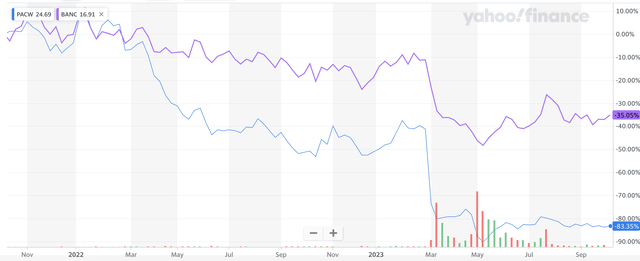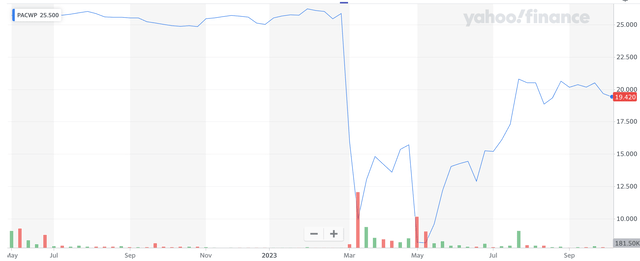Earlier this year, Banc of California (NYSE:BANC) and PacWest Bancorp (NASDAQ:PACW) announced to merge. The combined company will have over 70 branches all over California. In this analysis, we try to come up with an estimated valuation for the stocks of the two banks going into the merger.
Leading up to the Merger
Depositors Queueing In Front of SVB Amid Deposit Fears (CNN)
Amid the 2023 U.S. banking crisis, with several regional banks failing, all regional banks were suffering from high uncertainty and decreasing share prices. In March 2023, over the span of just 2 weeks, PACW posted a decline of ~65% on their common stock price, while BANC posted a decline of over ~25%. Over fears of a bank run on deposits and unrealised losses due to increasing interest rates, PACW was one of the regional banks hit the hardest.
After several announcements of PACW selling loans to improve balance sheet health and decrease uncertainties in the market, finally in July, the two banks announced their merger agreement. As deposits with PACW were continuing to decrease and the overall market sentiment was still negative surrounding the hurting bank, for PACW a merger might have been one of the only viable solutions for long-term survival.
Merger Details
PACW and BANC Prices (Yahoo Finance)
The planned merger of the two banks will result in the combined company to operate under the Banc of California name and brand. PACW stockholders will also receive BANC stock in return for their shares. So, even though PacWest Bank is bigger than Banc of California in pretty much all regards, this merger might also be referred to as an absorption of PacWest Bank by Banc of California. We should keep this fact in mind when looking at the merger details, PACW being under distress did not give them much of a bargaining power.
As per the companies’ estimations, the combined company will move on to become the 4th largest mid-sized bank in California by deposits.
Following the merger, PACW holders are set to receive 0.6569 shares of BANC for each of their PACW shares. Furthermore, each of the outstanding NASDAQ:PACWP preferred shares will receive an identical share of newly created preferred BANC shares. There is also an investment agreement set in place with investors Warburg Pincus LLC and Centerbridge Partners, L.P. (combined: the investors) to invest for newly issued BANC shares at the closing of the merger. The investors are set to invest an aggregate of ~$400m for a total of 32.6m common (and common-equivalent) stock. Additionally, the investors will receive warrants to purchase ~3m of common stock with an exercise price of $15.375. On completion of all merger transactions, the holder structure of the combined company will be as follows:
- Current PacWest holders will hold ~47% of the combined company
- Current BANC holders will hold ~34% of the combined company
- The investors will hold ~19% of the combined company
Based on these values, the investors are investing ~$400m in cash at a valuation of ~$2.1b for the combined company at a price of ~$12.30 per common stock. At that valuation, current PacWest holders will hold ~$987m worth of the combined company, while BANC holders will hold ~$714m. These values are slightly higher than the current market caps of PACW at ~$800m and ~$606m for BANC. Based on the latest earnings releases (here and here), BANC is adding tangible common equity of ~$881m, while PACW is adding ~1.95b. Subtracting unrealised losses for Held-to-Maturity (HTM) losses of ~$187m for PACW and ~$78m for BANC, this leaves combined tangible common equity minus unrealised losses for HTM securities of ~$2.6b. On top of this, the investors are adding $400m of fresh cash, leaving the total estimated tangible common equity of the combined merger after the closing at ~$3b.
In the last quarterly release, PacWest CEO shed some further light on the timing of the merger by saying:
We expect the closing of the merger to occur on or about November 30, 2023, subject to receipt of stockholder approvals.
Valuation after latest updates
While BANC is continually posting solid profits, and while PACW has put an effort to reduce risk and sell loans, it has posted net losses, but in doing so improves balance sheet health. I think still, both banks are structurally profitable. In the big picture, these ongoing losses are already priced in for PACW though, since the common stock is trading much lower than its tangible equity.
As per their last earnings release, PACW posted a net loss of ~$33m. PACW has sold big chunks of its loans portfolio, resulting in lower interest income, having a negative impact on revenues and profitability. BANC reported a quarterly adjusted income of ~$17m in its last quarterly earnings release. For 2024, however, the companies give an estimate of ~$1.65-$1.80 EPS in their merger presentation.
With multiple banks having exited the California market recently (meaning potential revenue increase), and the merger unlocking large synergy potential (meaning cost savings), I would expect EPS to significantly improve in the coming years following the merger.
Assuming a 10x multiple to the lower end of projected EPS (~$1.65), we end up with a price of ~$16.5 for the common stock. This would result in a total market cap of ~$2.8b for the combined company, ~34% higher than the investors paid for fresh equity in the merger transactions but still lower than estimated tangible common equity, subtracted by unrealised HTM losses, of ~$3b for the combined company.
While a 10x multiple on projected EPS might seem high for a mid-sized bank like the combined company will become, I think given the fact that the balance sheet will end up in a much better place after the merger (partly due to fresh capital), an upwards price correction closer to tangible common equity is reasonable. The merger combined with the fact that several competitors left the market can also unlock potential for higher-than-projected earnings for the years to come.
The Preferred Stock
PACWP Prices (Yahoo Finance)
As mentioned before, PacWest’s preferred stock (PACWP) is going to be converted to identical preferred stock of BANC. PACWP has a liquidation price of $25 but crashed to even under $10 earlier this year amid the banking crisis in the U.S. Even though PACWP’s price recovered to ~$19.4 as of writing, I believe the preferred stock still has favourable risk/reward.
With a current yield of almost 10%, it is a good, high-yield, long-term investment. The chances of the merger going through are very high and with fresh equity and unlocked synergies, especially after converting the preferred stock, chances of a default or stop of payment on the preferred stock are very low. The combined company’s tangible common equity provides significant margin of safety for investors.
What to look out for
In this analysis, we assumed that the merger between the two banks is going to be a success as planned. However, there is a remaining risk that, for whatever reason, the merger will not succeed as planned. Depending on the reason and the overall circumstances, this wouldn’t necessarily be bad for investors. However, it is important for investors to stay vigilant here and monitor the situation closely.
Any estimates in further earnings should also be closely verified based on the upcoming earnings releases of the banks and also those of competitors. There is still some uncertainty regarding the regional banking sector and also the economy as a whole, which means that investors should be increasingly cautious.
Conclusion
Based on this analysis, we conclude that the merger between PacWest and Banc of California can unlock future value for investors and is a likely net positive for both companies. At current prices, the two common stocks, PACW and BANC, as well as the preferred stock, PACWP, are reasonable investments, based on the tangible book value the combined company will offer and the potential for the combined company to improve the balance sheet, their revenue, and earnings following the merger.
Read the full article here



